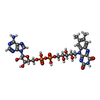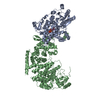+Search query
-Structure paper
| Title | Cryptochrome-Timeless structure reveals circadian clock timing mechanisms. |
|---|---|
| Journal, issue, pages | Nature, Vol. 617, Issue 7959, Page 194-199, Year 2023 |
| Publish date | Apr 26, 2023 |
 Authors Authors | Changfan Lin / Shi Feng / Cristina C DeOliveira / Brian R Crane /  |
| PubMed Abstract | Circadian rhythms influence many behaviours and diseases. They arise from oscillations in gene expression caused by repressor proteins that directly inhibit transcription of their own genes. The fly ...Circadian rhythms influence many behaviours and diseases. They arise from oscillations in gene expression caused by repressor proteins that directly inhibit transcription of their own genes. The fly circadian clock offers a valuable model for studying these processes, wherein Timeless (Tim) plays a critical role in mediating nuclear entry of the transcriptional repressor Period (Per) and the photoreceptor Cryptochrome (Cry) entrains the clock by triggering Tim degradation in light. Here, through cryogenic electron microscopy of the Cry-Tim complex, we show how a light-sensing cryptochrome recognizes its target. Cry engages a continuous core of amino-terminal Tim armadillo repeats, resembling how photolyases recognize damaged DNA, and binds a C-terminal Tim helix, reminiscent of the interactions between light-insensitive cryptochromes and their partners in mammals. The structure highlights how the Cry flavin cofactor undergoes conformational changes that couple to large-scale rearrangements at the molecular interface, and how a phosphorylated segment in Tim may impact clock period by regulating the binding of Importin-α and the nuclear import of Tim-Per. Moreover, the structure reveals that the N terminus of Tim inserts into the restructured Cry pocket to replace the autoinhibitory C-terminal tail released by light, thereby providing a possible explanation for how the long-short Tim polymorphism adapts flies to different climates. |
 External links External links |  Nature / Nature /  PubMed:37100907 PubMed:37100907 |
| Methods | EM (single particle) |
| Resolution | 3.3 Å |
| Structure data | EMDB-27335, PDB-8dd7: |
| Chemicals |  ChemComp-FAD: |
| Source |
|
 Keywords Keywords |  CIRCADIAN CLOCK PROTEIN / CIRCADIAN CLOCK PROTEIN /  Flavoprotein / Flavoprotein /  Nuclear import / Light-sensor / Armadillo-repeat protein Nuclear import / Light-sensor / Armadillo-repeat protein |
 Movie
Movie Controller
Controller Structure viewers
Structure viewers About Yorodumi Papers
About Yorodumi Papers







